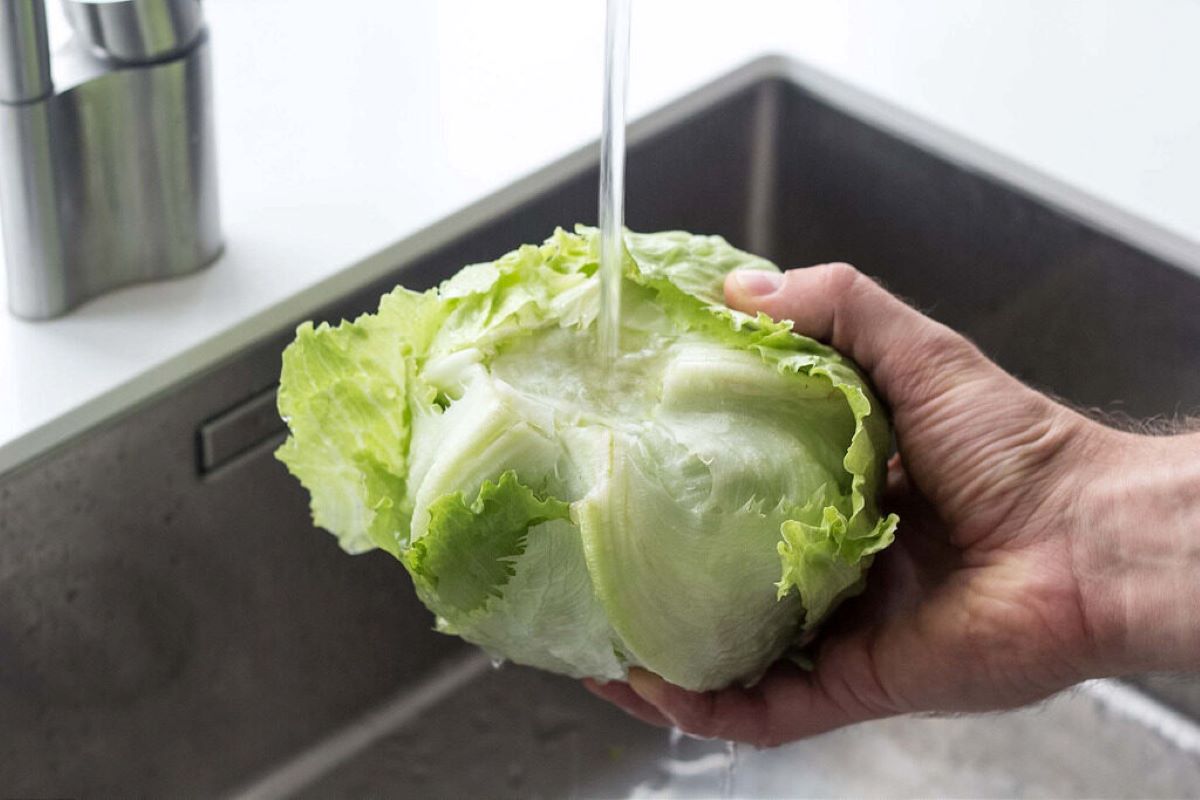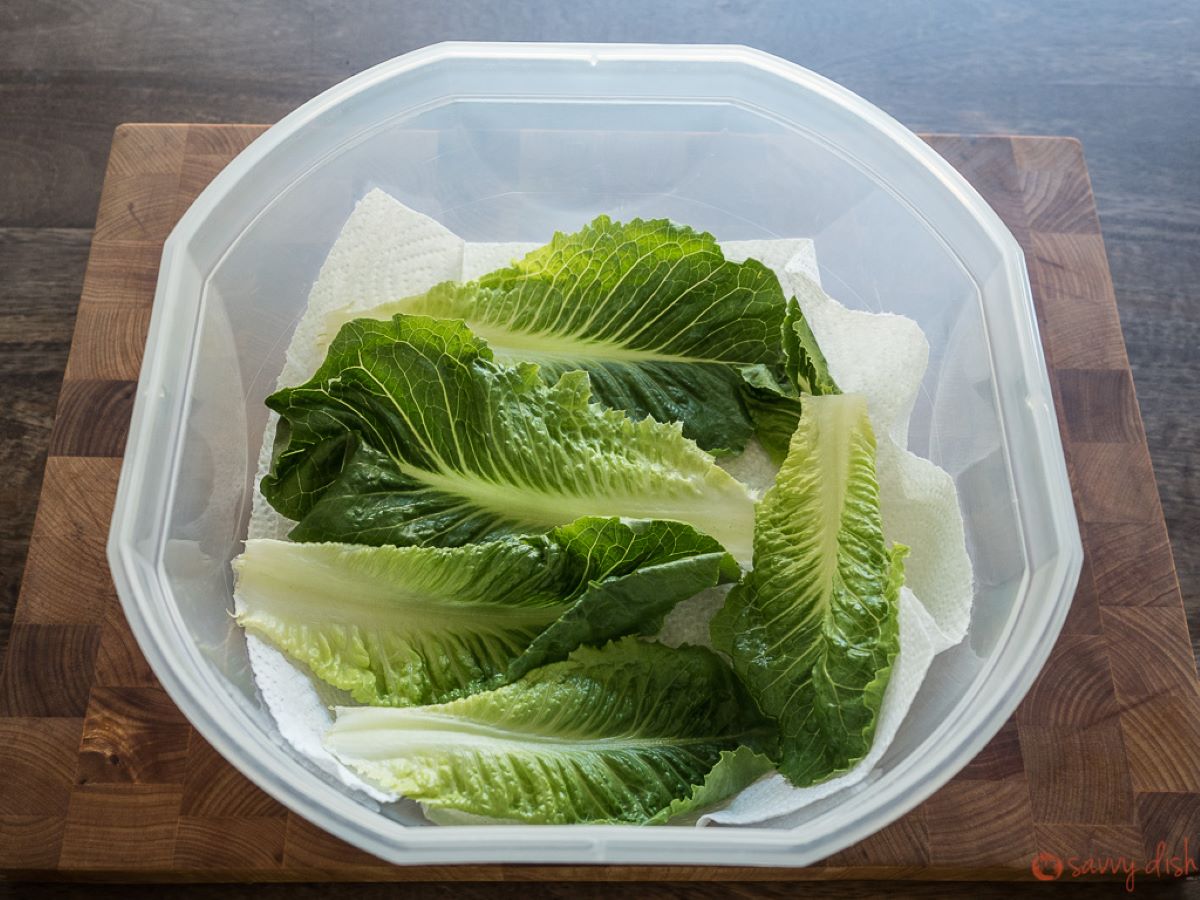

Articles
How To Store Iceberg Lettuce To Last Longer
Modified: October 20, 2024
Learn effective methods for storing iceberg lettuce to keep it fresh and crisp for a longer duration. Read our informative articles for helpful tips and techniques.
(Many of the links in this article redirect to a specific reviewed product. Your purchase of these products through affiliate links helps to generate commission for Storables.com, at no extra cost. Learn more)
Introduction
When it comes to enjoying fresh produce, iceberg lettuce is a popular choice for its crisp texture and mild flavor. Whether you’re preparing a refreshing salad, adding a crunch to your sandwich, or using it as a base for wraps, properly storing iceberg lettuce is essential to have it last longer and maintain its quality.
In this article, we will explore different methods and tips for storing iceberg lettuce to help it stay fresh and crisp for as long as possible. By following these guidelines, you can minimize waste and maximize the shelf life of your iceberg lettuce, ensuring that you always have a refreshing and healthy ingredient on hand.
Key Takeaways:
- Proper storage of iceberg lettuce is crucial to maintain its crispness, freshness, and nutritional value, reducing food waste and ensuring safe consumption.
- Various storage methods, including refrigerator, plastic bag, mason jar, and freezing, offer options to extend the shelf life of iceberg lettuce and cater to individual preferences.
Read more: How To Store Iceberg Lettuce
Understanding Iceberg Lettuce
Iceberg lettuce, also known as crisphead lettuce, is a variety of lettuce that is characterized by its tightly packed, pale green leaves and its mild taste. It is a popular choice for its versatility and ability to add a crispy texture to various dishes.
However, iceberg lettuce has a higher water content compared to other lettuce varieties. This means that it is more prone to wilting and spoilage if not stored properly. Understanding the nature of iceberg lettuce is crucial in determining the best storage methods to extend its freshness.
Why is Proper Storage Important?
Proper storage of iceberg lettuce is important for several reasons. Firstly, storing it correctly helps to maintain its crisp texture and prevent wilting. Nobody enjoys a limp and soggy salad.
Secondly, storing iceberg lettuce properly can help to prevent the growth of bacteria and fungi, reducing the risk of foodborne illnesses. By keeping it in optimal conditions, you can ensure that your lettuce remains safe to consume.
Lastly, storing iceberg lettuce correctly can help to reduce food waste. When lettuce is not stored properly, it tends to spoil faster, leading to unnecessary waste. By implementing the right storage methods, you can make the most of your iceberg lettuce and reduce the amount of food that ends up in the trash.
Key Takeaways:
- Proper storage of iceberg lettuce is crucial to maintain its crispness, freshness, and nutritional value, reducing food waste and ensuring safe consumption.
- Various storage methods, including refrigerator, plastic bag, mason jar, and freezing, offer options to extend the shelf life of iceberg lettuce and cater to individual preferences.
Read more: How To Store Iceberg Lettuce
Understanding Iceberg Lettuce
Iceberg lettuce, also known as crisphead lettuce, is a popular variety of lettuce that is widely used in salads, sandwiches, and wraps. It gets its name from the way the tightly packed leaves form a firm, dense head.
Iceberg lettuce is known for its mild flavor and crisp texture. The leaves are pale green on the outside and have a white, crunchy core. While it may not have the same nutritional value as darker leafy greens like spinach or kale, it is still a good source of vitamins A and K.
One of the reasons why iceberg lettuce is a favorite among many is its versatility. Its mild taste allows it to complement a wide range of other ingredients and dressings. It adds a refreshing crunch to dishes and acts as a blank canvas for flavors to shine.
However, it’s important to note that iceberg lettuce has a high water content, which makes it more susceptible to wilting and browning. This means that proper storage is crucial to maintain its freshness and extend its shelf life.
When selecting iceberg lettuce, look for heads that have crisp, tightly packed leaves. Avoid ones that appear mushy, slimy, or have discoloration, as these are signs of spoilage. Fresh lettuce should also have a slightly sweet smell.
It’s worth mentioning that iceberg lettuce has a reputation for being less nutritious compared to other leafy greens. While it may not offer the same level of vitamins and minerals as darker varieties, it still provides dietary fiber and can be a part of a healthy, balanced diet.
Overall, understanding the characteristics and qualities of iceberg lettuce is essential to properly store and enjoy this versatile vegetable. By taking care of this crispy green, you can elevate your salads and other dishes while minimizing food waste.
Why is Proper Storage Important?
Proper storage of iceberg lettuce is crucial to maintain its quality, freshness, and safety. Failure to store it correctly can lead to wilting, spoilage, and potentially harmful bacterial growth. Here are several reasons why proper storage is important for iceberg lettuce:
1. Retaining Crispness: Iceberg lettuce is prized for its crisp texture, which adds a delightful crunch to salads and other dishes. Proper storage helps to preserve the crispness of the leaves, ensuring a satisfying eating experience.
2. Minimizing Wilting: Iceberg lettuce has a high water content, making it prone to wilting if not stored properly. By storing it in the right conditions, such as in a cool environment, you can slow down the wilting process and extend the freshness of the lettuce.
3. Preventing Spoilage: Like all fresh produce, iceberg lettuce is susceptible to spoilage. Proper storage can help prevent bacterial and fungal growth, which can cause the lettuce to rot and become unsafe to eat. Reducing spoilage not only saves money but also decreases food waste.
4. Ensuring Food Safety: When lettuce is not stored correctly, there is a higher risk of bacteria such as E. coli or Salmonella multiplying on the leaves. These bacteria can cause foodborne illnesses if consumed. By keeping the lettuce in optimal conditions, you can minimize the risk of contamination and ensure food safety.
5. Extending Shelf Life: Proper storage techniques can significantly extend the shelf life of iceberg lettuce. This allows you to enjoy the lettuce for a longer period, reducing the need to frequently purchase fresh produce and potentially saving money in the long run.
6. Maintaining Nutrient Content: While iceberg lettuce may not be as nutrient-dense as darker leafy greens, it still contains vitamins and minerals. Proper storage helps to maintain the nutritional value of the lettuce, ensuring you get the maximum benefits when consuming it.
By understanding the importance of proper storage and implementing the right techniques, you can prolong the shelf life of iceberg lettuce, maintain its quality, and reduce food waste. With a little care and attention, you can enjoy fresh, crisp lettuce in your meals for a longer period of time.
Read more: How To Store Iceberg Lettuce In Fridge
Tips for Storing Iceberg Lettuce
To ensure that your iceberg lettuce stays fresh and crisp as long as possible, consider the following tips for proper storage:
1. Keep it Cool: Iceberg lettuce is sensitive to heat, so it’s best to store it in a cool environment. Aim for a temperature between 32 and 40 degrees Fahrenheit (0 to 4 degrees Celsius). This can help slow down the wilting process and maintain the crispness of the leaves.
2. Avoid Moisture: Excess moisture can lead to bacterial growth and cause the lettuce to become mushy or slimy. Before storing, make sure the leaves are dry by gently patting them with a clean towel or using a salad spinner. Avoid washing the lettuce until you’re ready to use it.
3. Don’t Cut Too Soon: If you’ve purchased a whole head of iceberg lettuce, it’s best to leave it intact until you’re ready to use it. Cutting or tearing the lettuce exposes more surface area to air, which can cause it to wilt faster. It’s recommended to wait and prep the lettuce just before serving.
4. Store in a Plastic Bag: One common method for storing iceberg lettuce is to place it in a plastic bag. Before sealing the bag, make sure to remove any excess air to prevent moisture buildup. This method helps to retain moisture and keep the leaves crisp.
5. Use a Moist Paper Towel: Alternatively, you can wrap the lettuce in a damp paper towel before placing it in the plastic bag. The moisture from the towel helps to create a humid microclimate, keeping the lettuce fresh without making it too wet.
6. Store Separately: If you have other fruits and vegetables in the refrigerator, it’s best to store iceberg lettuce separately. Some fruits produce ethylene gas, which can speed up the ripening process and cause the lettuce to spoil faster. Keep the lettuce away from ethylene-producing produce like apples and bananas.
7. Avoid Squeezing or Crushing: Handle iceberg lettuce with care to avoid bruising or crushing the leaves. Squeezing or applying excess pressure can damage the structure of the lettuce and accelerate wilting.
8. Follow the First-In, First-Out Rule: If you have multiple heads of lettuce, use the oldest one first. This ensures that you’re consuming the lettuce before it reaches its expiration date, reducing waste and ensuring freshness.
By following these tips, you can prolong the shelf life of your iceberg lettuce and enjoy fresh, crisp leaves in your salads, sandwiches, and other dishes for an extended period of time.
To store iceberg lettuce and make it last longer, wrap the whole head in a paper towel and place it in a plastic bag in the crisper drawer of the refrigerator. The paper towel will absorb excess moisture and prevent wilting.
Method 1: Refrigerator Storage
Refrigerating iceberg lettuce is a common and effective method for keeping it fresh and crisp. Follow these steps to properly store iceberg lettuce in the refrigerator:
1. Prepping the Lettuce: Start by removing any damaged or wilted outer leaves from the head of lettuce. Rinse the remaining leaves under cool water to remove any dirt or debris. Gently pat them dry with a clean towel or use a salad spinner to remove excess moisture.
2. Wrapping in Paper Towels: Take a few clean, dry paper towels and wrap them around the lettuce leaves. The paper towels help to absorb excess moisture and prevent the lettuce from becoming soggy. Make sure to wrap the lettuce loosely to allow for air circulation.
3. Placing in a Perforated Plastic Bag: Once the lettuce is wrapped in paper towels, place it inside a perforated plastic bag. The perforations in the bag allow some airflow while retaining moisture. If you don’t have a perforated bag, you can create your own by poking a few small holes in a regular plastic bag.
4. Storing in the Crisper Drawer: The crisper drawer in your refrigerator is designed to provide a slightly higher humidity level, making it an ideal spot for storing lettuce. Place the bag of wrapped lettuce in the crisper drawer, away from any ethylene-producing fruits or vegetables.
5. Checking and Refreshing: Check the lettuce periodically to ensure it remains fresh and crisp. If the paper towels become damp, replace them with fresh ones. This helps to maintain the optimal moisture level and prevent the lettuce from wilting.
By following this method, you can extend the shelf life of your iceberg lettuce and enjoy crunchy, refreshing leaves for a longer period. Remember to store the lettuce in the refrigerator at a temperature between 32 and 40 degrees Fahrenheit (0 to 4 degrees Celsius) to maintain its freshness.
Method 2: Plastic Bag Storage
If you’re looking for a simple and convenient way to store iceberg lettuce, using a plastic bag can be an effective method. Here’s how you can store iceberg lettuce in a plastic bag:
1. Preparing the Lettuce: Start by removing any damaged or wilted outer leaves from the iceberg lettuce head. Rinse the remaining leaves under cool water to remove any dirt or debris. Gently pat them dry with a clean towel or use a salad spinner to remove excess moisture.
2. Choosing a Sealable Plastic Bag: Select a resealable plastic bag that is large enough to comfortably accommodate the lettuce without squishing it. Opt for a thicker, sturdy bag to prevent any punctures or tears.
3. Adding a Damp Paper Towel: Take a clean, damp paper towel and gently squeeze out any excess water. Place the damp paper towel into the plastic bag before adding the lettuce. The moisture from the towel will help to create a humid environment inside the bag, keeping the lettuce fresh without making it too wet.
4. Placing the Lettuce in the Bag: Put the prepped lettuce into the plastic bag, on top of the damp paper towel. Try to arrange the leaves as flat as possible, avoiding excessive overlapping or folding. Leave a little room at the top of the bag to allow for some air circulation.
5. Sealing the Bag: Seal the plastic bag tightly, ensuring there are no openings or gaps. This helps to maintain the humidity level inside the bag and prevent moisture loss from the lettuce.
6. Storing in the Refrigerator: Place the sealed bag of lettuce in the refrigerator. You can keep it in the crisper drawer, or if space is limited, it can be stored on a shelf. Avoid placing the bag near ethylene-producing fruits and vegetables as it can speed up the wilting process.
7. Checking and Refreshing: Regularly check the lettuce for any signs of spoilage or wilting. If the paper towel becomes dry, spritz it lightly with water to rehydrate it. Replace the paper towel if it becomes too wet or starts to develop a foul odor.
Using a plastic bag for storage provides a convenient and cost-effective solution to keep your iceberg lettuce fresh and crunchy. By following this method, you can extend the shelf life of your lettuce and enjoy its crispness in salads, sandwiches, and more.
Method 3: Mason Jar Storage
If you prefer a more sustainable and eco-friendly option for storing your iceberg lettuce, using a mason jar can be a great choice. Here’s how you can store iceberg lettuce in a mason jar:
1. Preparing the Lettuce: Start by washing the iceberg lettuce leaves under cool water to remove any dirt or debris. Gently pat them dry with a clean towel or use a salad spinner to remove excess moisture. Tear the leaves into smaller, manageable pieces that will fit inside the mason jar.
2. Selecting a Mason Jar: Choose a wide-mouth mason jar that is large enough to accommodate the lettuce leaves. A pint-sized jar should be sufficient for storing a small head of iceberg lettuce.
3. Layering the Lettuce: Begin by placing a layer of torn lettuce leaves at the bottom of the mason jar. Make sure to pack them loosely to allow for air circulation. Continue layering the leaves until the jar is filled, leaving a small space at the top.
4. Adding a Damp Paper Towel: Take a clean, damp paper towel and gently squeeze out any excess water. Place the damp paper towel on top of the lettuce leaves in the jar. The moisture from the towel will help to keep the lettuce hydrated and prevent wilting.
5. Sealing the Jar: Place the lid on the mason jar and screw it on tightly. This provides an airtight seal to maintain the freshness of the lettuce and prevent any moisture loss.
6. Storing in the Refrigerator: Place the sealed mason jar of lettuce in the refrigerator. It can be stored on a shelf or in the door compartment. Just ensure that it is not exposed to excessive temperature fluctuations or direct sunlight.
7. Using as Needed: When you’re ready to use the lettuce, simply unscrew the jar lid and remove the desired amount of leaves. Tightly seal the jar and promptly return it to the refrigerator to maintain the freshness of the remaining lettuce.
Storing iceberg lettuce in a mason jar not only helps to keep it fresh and crisp but also reduces the use of single-use plastic bags or containers. It allows for easy access and portioning, making it a convenient storage method for busy individuals or meal preppers.
By following this method, you can enjoy fresh and crunchy lettuce for a longer duration, minimizing waste and maximizing the shelf life of your iceberg lettuce.
Read more: How To Store Iceberg Lettuce After Cutting
Method 4: Freezing Iceberg Lettuce
While freezing iceberg lettuce is not a common practice due to its high water content, it can be done if you want to preserve it for longer periods. Freezing may cause the texture to change, making the lettuce wilt and lose its crispness. However, if you plan to use the lettuce in cooked dishes or smoothies, freezing can be a viable option. Here’s how you can freeze iceberg lettuce:
1. Preparing the Lettuce: Start by washing the iceberg lettuce leaves thoroughly under cool water to remove any dirt or debris. Gently pat them dry with a clean towel or use a salad spinner to remove excess moisture. Tear the leaves into smaller, freezer-friendly pieces.
2. Blanching the Lettuce: Blanching helps to preserve the color and texture of the lettuce before freezing. Bring a pot of water to a boil and place the torn lettuce leaves into the boiling water for about 1-2 minutes. After blanching, immediately transfer the leaves to a bowl of ice water to halt the cooking process.
3. Draining and Drying: Once the lettuce has cooled in the ice water, remove it and drain off the excess water. Gently pat the leaves dry with a clean towel or allow them to air dry on a clean kitchen towel or paper towels.
4. Packing for Freezing: Place the blanched and dried lettuce leaves into airtight freezer bags or freezer-safe containers. Squeeze out as much air as possible before sealing the bags or containers tightly. Alternatively, you can vacuum-seal the lettuce to prevent freezer burn and extend its shelf life.
5. Labeling and Dating: It’s important to label the bags or containers with the date of freezing so you can keep track of their shelf life. Use a permanent marker to write the date on the packaging.
6. Freezing and Storage: Place the bags or containers of iceberg lettuce in the freezer. Ensure they are arranged in a single layer for quicker freezing. Once frozen, you can stack them to save space. It’s best to use the frozen lettuce within 3-4 months for optimal quality.
7. Thawing and Using: When you’re ready to use the frozen iceberg lettuce, thaw it in the refrigerator overnight. Avoid thawing it at room temperature, as this can lead to excessive moisture and texture changes. Use the thawed lettuce in cooked dishes such as soups, stews, or stir-fries, as the texture may not be suitable for raw consumption.
While freezing iceberg lettuce may alter its texture, it can still be a convenient option to preserve it for certain applications. Remember to blanch the lettuce before freezing to help retain its color and prevent potential microbial growth. With proper freezing and storage techniques, you can enjoy iceberg lettuce in your favorite cooked dishes even when it’s out of season.
How to Revive Wilting Iceberg Lettuce
There’s nothing more disappointing than reaching for your iceberg lettuce only to find it wilted and limp. However, don’t throw it away just yet! There are several methods you can try to revive wilting iceberg lettuce:
1. Ice Water Bath: Fill a large bowl or sink with ice-cold water. Submerge the wilted lettuce leaves in the water for about 15-30 minutes. The cold temperature will help to crisp up the leaves and revive their texture. After the ice water bath, gently pat the leaves dry with a clean towel before using them.
2. Refrigerator Soak: If you don’t have ice-cold water, you can also try soaking the lettuce leaves in cold water in the refrigerator. Place the wilted leaves in a bowl of cold water and refrigerate for 1-2 hours. This method can help to rehydrate the leaves and restore some of their crunch.
3. Trim and Submerge: If the outer leaves are extremely wilted, remove them and focus on reviving the fresher inner leaves. Fill a container or glass with enough water to submerge the lettuce stems. Trim the ends of the stems and place the lettuce head, cut side down, in the water. Place the container in the refrigerator and leave it for a few hours or overnight. The water will hydrate the stems, helping to perk up the leaves.
4. Salad Spinner Method: If you have a salad spinner, you can use it to revive wilted iceberg lettuce. Rinse the lettuce leaves under cool water and gently shake off the excess moisture. Place the lettuce in the salad spinner and give it a few spins to remove any remaining water. The centrifugal force of the spinner can revive the leaves, making them crispier and more appealing.
5. Ice Cube Trick: For a quick fix, place a few ice cubes on top of the wilted lettuce leaves and let them sit for a few minutes. The cold temperature from the ice cubes can help to revive the leaves and restore their crunchiness. Afterward, gently pat the leaves dry with a clean towel.
6. Use It In Cooking: If all else fails, and the lettuce still doesn’t regain its crisp texture, you can still salvage it by using it in cooked dishes. Wilted iceberg lettuce can be added to soups, stir-fries, or sautés, where its texture won’t be as noticeable.
These methods can help revive wilting iceberg lettuce, improving its texture and making it more enjoyable to eat. It’s important to note that these techniques may not completely restore the lettuce to its original state, but they can help salvage it and prevent unnecessary food waste.
Conclusion
Properly storing iceberg lettuce is essential to maintain its freshness, crispness, and nutritional value. By implementing the right storage methods and following helpful tips, you can extend the shelf life of your iceberg lettuce and reduce food waste.
We discussed various methods for storing iceberg lettuce, including refrigerator storage, plastic bag storage, mason jar storage, and even freezing. Each method has its advantages, so choose the one that suits your needs and preferences.
Refrigerator storage involves prepping the lettuce, wrapping it in paper towels, and placing it in a perforated plastic bag. This method helps maintain freshness and crispness. Plastic bag storage involves placing the lettuce in a resealable bag with a damp paper towel to keep it hydrated.
Mason jar storage is a sustainable option that allows for convenient access and portioning. While freezing iceberg lettuce is not as common, it can be done if you plan to use the lettuce in cooked dishes or smoothies.
Lastly, we explored how to revive wilting iceberg lettuce using ice water baths, refrigerator soaks, trimming and submerging, salad spinners, and the ice cube trick. These techniques can help bring the limp leaves back to life, giving you a second chance to enjoy your lettuce.
Remember, proper storage not only helps maintain the crispness and quality of iceberg lettuce but also reduces the risk of foodborne illnesses and minimizes food waste.
So next time you bring home a head of iceberg lettuce, take the time to store it correctly and make the most of this versatile vegetable. With the right storage methods and care, you can enjoy fresh and crisp iceberg lettuce in your meals for as long as possible.
From refrigerator to plate, happy storing and enjoying your iceberg lettuce!
Frequently Asked Questions about How To Store Iceberg Lettuce To Last Longer
Was this page helpful?
At Storables.com, we guarantee accurate and reliable information. Our content, validated by Expert Board Contributors, is crafted following stringent Editorial Policies. We're committed to providing you with well-researched, expert-backed insights for all your informational needs.














0 thoughts on “How To Store Iceberg Lettuce To Last Longer”